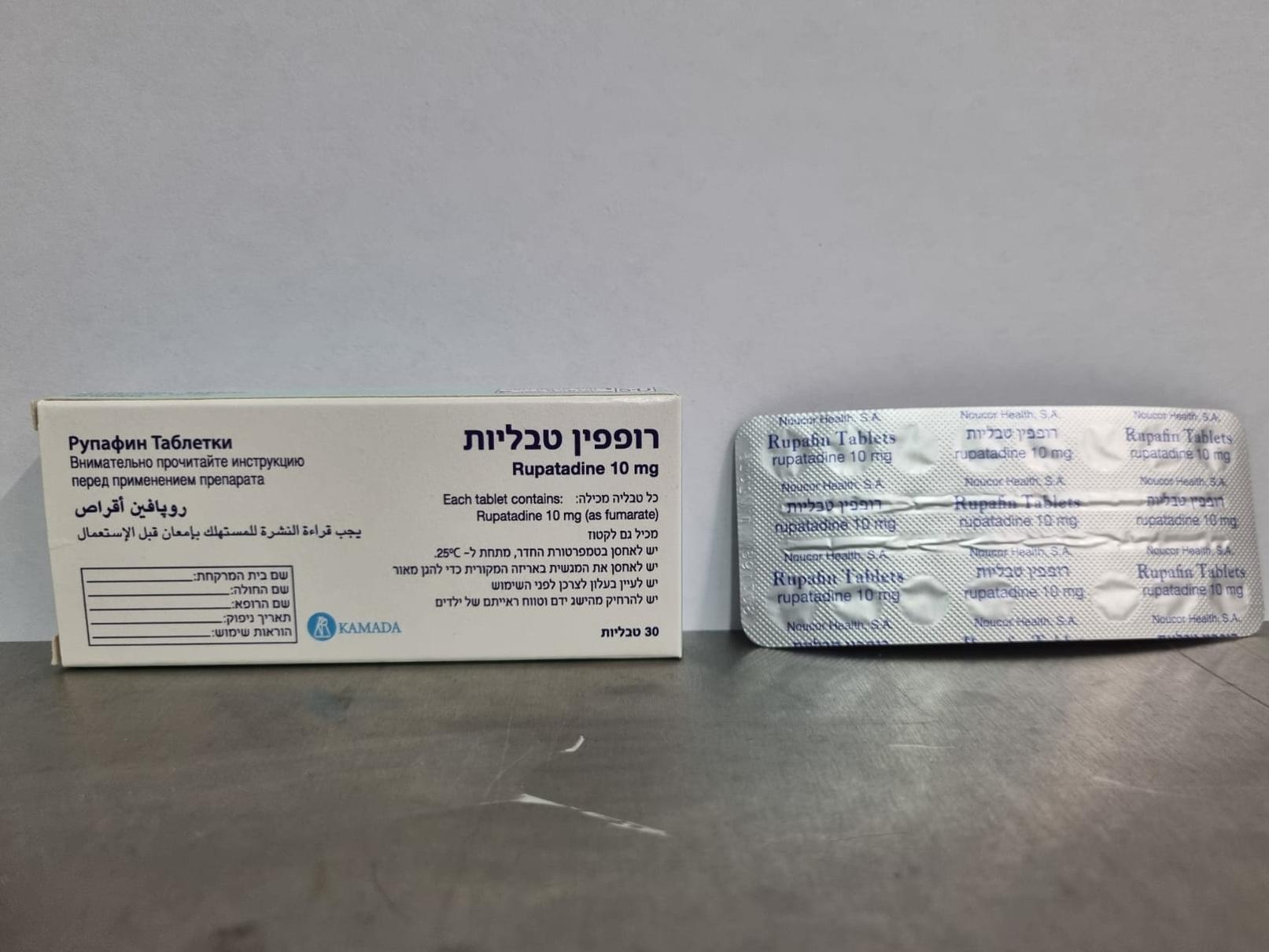Quest for the right Drug

רופפין טבליות RUPAFIN TABLETS (RUPATADINE AS FUMARATE)
תרופה במרשם
תרופה בסל
נרקוטיקה
ציטוטוקסיקה
צורת מתן:
פומי : PER OS
צורת מינון:
טבליה : TABLETS
עלון לרופא
מינוניםPosology התוויות
Indications תופעות לוואי
Adverse reactions התוויות נגד
Contraindications אינטראקציות
Interactions מינון יתר
Overdose הריון/הנקה
Pregnancy & Lactation אוכלוסיות מיוחדות
Special populations תכונות פרמקולוגיות
Pharmacological properties מידע רוקחי
Pharmaceutical particulars אזהרת שימוש
Special Warning עלון לרופא
Physicians Leaflet
Pharmacological properties : תכונות פרמקולוגיות
Pharmacodynamic Properties
5.1 Pharmacodynamic properties Pharmacotherapeutic group: other antihistamines for systemic use, ATC code: R06A X28. Rupatadine is a second-generation antihistamine, long-acting histamine antagonist, with selective peripheral H1-receptor antagonist activity. Some of the metabolites (desloratadine and its hydroxylated metabolites) retain an antihistaminic activity and may partially contribute to the overall efficacy of the drug. In vitro studies with rupatadine at high concentration have shown an inhibition of the degranulation of mast cells induced by immunological and non-immunological stimuli as well as the release of cytokines, particularly of the TNFα in human mast cells and monocytes. The clinical relevance of the observed experimental data remains to be confirmed. Clinical trials in volunteers (n= 393) and patients (n=2650) with allergic rhinitis and chronic idiopathic urticaria did not show significant effect on the electrocardiogram when rupatadine was administered at doses ranging from 2 mg to 100 mg. Chronic idiopathic urticaria was studied as a clinical model for urticarial conditions, since the underlying pathophysiology is similar, regardless of etiology, and because chronic patients can be more easily recruited prospectively. Since histamine release is a causal factor in all urticarial diseases, rupatadine is expected to be effective in providing symptomatic relief for other urticarial conditions, in addition to chronic idiopathic urticaria, as advised in clinical guidelines. In a placebo-controlled trials in patients with Chronic Idiopathic Urticaria, rupatadine was effective reducing the mean pruritus score from baseline over the 4 week treatment period (change vs baseline: rupatadine 57.5%, placebo 44.9%) and decreasing the mean number of wheals (54.3% vs 39.7%).
Pharmacokinetic Properties
5.2 Pharmacokinetic properties Absorption and bioavailability Rupatadine is rapidly absorbed after oral administration, with a tmax of approximately 0.75 hours after intake. The mean Cmax was 2.6 ng/ml after a single oral dose of 10 mg and 4.6 ng/ml after a single oral dose of 20 mg. Pharmacokinetics of rupatadine was linear for a dose between 10 and 20 mg after single and repeated doses. After a dose of 10 mg once a day for 7 days, the mean Cmax was 3.8 ng/ml. The plasma concentration followed a bi-exponential drop-off with a mean elimination half-life of 5.9 hours. The binding-rate of rupatadine to plasma proteins was 98.5- 99%. As rupatadine has never been administered to humans by intravenous route, no data is available on its absolute bioavailability. Effect of the intake of food Intake of food increased the systemic exposure (AUC) to rupatadine by about 23%. The exposure to one of its active metabolites and to the main inactive metabolite was practically the same (reduction of about 5% and 3% respectively). The time taken to reach the maximum plasma concentration (tmax) of rupatadine was delayed by 1 hour. The maximum plasma concentration (Cmax) was not affected by food intake. These differences had no clinical significance. Metabolism and elimination In a study of excretion in humans (40 mg of 14C-rupatadine), 34.6% of the radioactivity administered was recovered in urine and 60.9% in faeces collected over 7 days. Rupatadine undergoes considerable pre-systemic metabolism when administered by oral route. The amounts of unaltered active substance found in urine and faeces were insignificant. This means that rupatadine is almost completely metabolised. Roughly, the active metabolites desloratadine and other hydroxylated derivatives accounted for 27% and 48%, respectively, of the total systemic exposure of the active substances. In vitro metabolism studies in human liver microsomes indicate that rupatadine is mainly metabolised by the cytochrome P450 (CYP 3A4). Based on in vitro studies the inhibitory potential of rupatadine towards CYP1A2, CYP2B6, CYP2C8, CYP2C19, UGT1A1 and UGT2B7, is unlikely. Rupatadine is not expected to inhibit the following transporters in the systemic circulation OATP1B1, OATP1B3 and BCRP (breast cancer resistance protein) hepatic and intestinal. Furthermore, a mild inhibition was detected of the intestinal P-gp (P-glycoprotein). An in vitro induction CYP study the risk of CYP1A2, CYP2B6 and CYP3A4 induction in the liver in vivo by rupatadine is considered unlikely. Based on in vivo study, rupatadine acts as a mild inhibitor of CYP3A4. Specific patient groups In a study on healthy volunteers to compare the results in young adults and elderly patients, the values for AUC and Cmax for rupatadine were higher in the elderly than in young adults. This is probably due to a decrease of the first-pass hepatic metabolism in the elderly. These differences were not observed in the metabolites analysed. The mean elimination half-life of rupatadine in elderly and young volunteers was 8.7 hours and 5.9 hours respectively. As these results for rupatadine and for its metabolites were not clinically significant, it was concluded that it is not necessary to make any adjustment when using a dose of 10 mg in the elderly.

שימוש לפי פנקס קופ''ח כללית 1994
לא צוין
תאריך הכללה מקורי בסל
לא צוין
הגבלות
לא צוין
מידע נוסף
